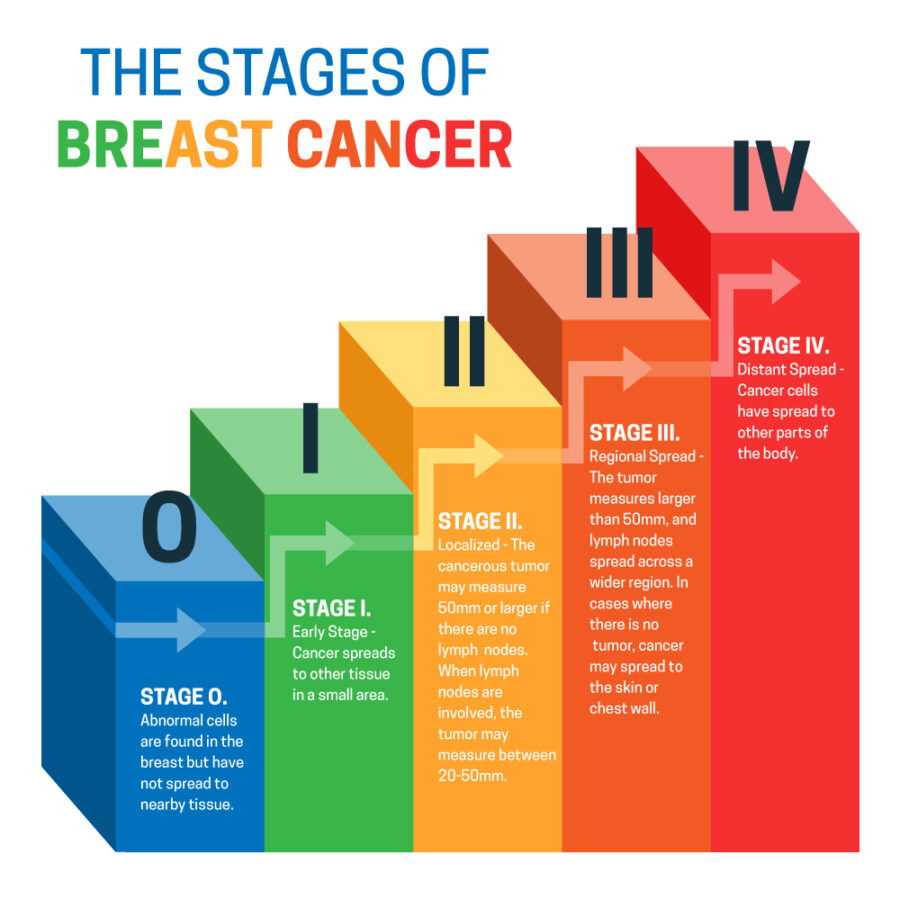Considering that there are more than 3.1 million breast cancer survivors as reported by the American Cancer Society, most people are personally affected by breast cancer either directly or through association. Understanding the stages of breast cancer and prognosis for each stage can be extremely confusing. Thankfully, there is a wealth of information available for those who are dealing with a breast cancer diagnosis and for their families. The following can help you interpret these facts and better understand the stages of breast cancer and prognosis for each.
How Breast Cancer Is Staged
Breast cancer staging ranges from 0 to 4, making a total of 5 possible stages. As of 2018, the standard for staging breast cancer now takes into consideration 7 factors to reach a more exact diagnosis with varying degrees of treatment options. According to Breastcancer.org, the following parameters help your physician to reach a decision on the degree of the cancer, treatment and prognosis.
- Tumor (T) – size and whether it has spread into neighboring tissues
- Lymph Node Involvement (N) – whether it has spread into the lymph nodes located in the underarm (axillary) region
- Metastasis (M) – whether the cancer has spread outside of the breast
- Tumor Grade – From 1 (low grade), 2 (moderate grade), to 3 (high grade), the grade assesses the look of the cancer cells and the rate at which they are dividing to make new cancer cells.
- Hormone Receptor Status – The hormone receptors are proteins found in breast cancer cells that respond to cues from either the hormones, estrogen (ER+) or progesterone (PR+). If receptive to these, the cancer cells grow in response to signals from these hormones.
- HER2 status – Human epidermal growth factor receptor 2 is the gene responsible for making receptor proteins for the breast tissue. In healthy breast tissue, these receptors control breast tissue growth. In 25% of cases, the HER2 gene dysfunctions, resulting in overproduction of the receptor proteins, uncontrolled growth and division of breast tissue cells.
- Oncotype DX test – A genetic test that helps your oncologist determine how your cancer will respond to different treatment modalities.
Stage 0
Stage 0 – Also known as DCIS (ductal carcinoma in situ). This is a non-invasive cancer that is confined to the milk ducts of the breast. In situ means “in place”, meaning that these abnormal cancer cells have not spread beyond this original site. Non-invasive breast cancer is very treatable when caught at this stage.
Stage 1
Invasive breast cancer meaning that cancer cells are invading the spaces of the surrounding breast tissue.
1A – The tumor measures up to 2 centimeters and has not spread outside of the breast.
1B – There are either small groups of cancer cells (no larger than 2 millimeters) found in the lymph nodes or there is both a tumor (not greater than 2 cm) in the breast and cancer cells (no larger than 2 mm) in the lymph nodes.
Stage 2
2A
- No breast tumor but cancer cells (larger than 2 mm) found in the lymph nodes
- Tumor smaller than 2 cm and has spread to lymph nodes
- Tumor between 2 and 5 cm but has not spread to lymph nodes
2B
- Tumor between 2-5 cm with spread to lymph nodes
- Tumor larger than 5 cm but no lymph node involvement
Stage 3
3A
- No tumor or tumor of any size and spread to 4-9 lymph nodes
- Tumor larger than 5 cm with small groups of breast cancer cells (no greater than 2 mm) found in lymph nodes
- Tumor larger than 5 cm with spread to 1-3 lymph nodes
3B
- Tumor may be any size and has spread to the skin or chest wall resulting in swelling or an ulcer
- May have spread to up to 9 lymph nodes
Inflammatory breast cancer may be staged as 3B and will manifest symptoms such as redness, warmth and swelling.
3C
- No tumor or tumor of any size with spread to chest wall or skin
- Has spread to 10 or more axillary lymph nodes
- Has spread to lymph nodes below or above the collarbone
- Has spread to lymph nodes near the breastbone
Stage 4
Advanced or metastatic breast cancer that has spread beyond the breast and lymph nodes. Common areas of metastasis are lungs, brain, liver, skin, bones or distant lymph nodes.
Early screening methods such as performing monthly breast self-examination and mammography can catch abnormalities that could be indicative of early breast cancer. It’s recommended to follow up regularly with your physician to receive the necessary checkups required for your age group and risk category.
Survival Rates According to Breast Cancer Stage
 With treatment, a very positive prognosis is realistic. Even though breast cancer is the second deadliest form of cancer for women, survival rates are increasing due to improved treatment modalities and earlier and more effective screening methods.
With treatment, a very positive prognosis is realistic. Even though breast cancer is the second deadliest form of cancer for women, survival rates are increasing due to improved treatment modalities and earlier and more effective screening methods.
According to The American Society of Clinical Oncology, the following statistics reflect 5 year survival rates for those with varying stages of breast cancer.
- Stage 0 and Stage 1 – No spread of cancer outside of the breast and no lymph node involvement = 99% survival rate
- Stage 1-3 – Spread to regional lymph nodes = 85% survival rate
- Stage 4 – Metastasis and spread to distant parts of the body = 27% survival rate
Early diagnosis and treatment is imperative for an increased survival rate. Approximately 62% of breast cancers are diagnosed at the non-invasive stage, meaning a better prognosis for recovery and remission.
At whatever stage you find yourself, a fully accredited cancer center with a personal touch can provide peace of mind as you progress through your cancer treatment. With a team of qualified oncologists, radiologists, care navigators and more, cancer treatment at River Forest Medical Campus is both compassionate and personalized for your individual needs.

